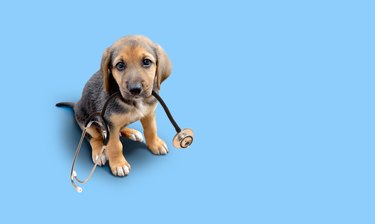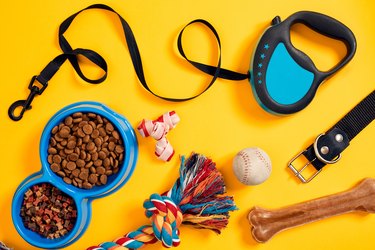
Ideally, puppies remain close to their mothers during their first 2 months of life, but that's not always possible. Luckily, pups abandoned or orphaned at 4 weeks can still grow into healthy, happy dogs with the supervision of a surrogate human. A puppy who has benefited from his mother's constant care and attention for a month is poised to thrive if you'll diligently assume his care.
Your puppy’s development
Video of the Day
Take your puppy to a veterinarian as soon as possible so he can be weighed and evaluated. Your newest little pup will still be nursing, but can lap water from a stable, shallow dish and is about ready to begin the transition to solid food.
Video of the Day
By a month of age, pups have fully developed vision and are increasingly energetic and adventuresome. Your pup should be eager to explore his immediate surroundings and will walk, trot, roll around, and play. He may be comfortable being alone for short periods of time while confined in the safety of his crate.
Ensuring healthy potty time
A healthy 1-month-old puppy should eliminate waste on his own and attempt to clean himself. If you see that he isn't able to potty, though, you'll need to stimulate your little one to urinate and defecate after meals by wiping his genitals with a wash cloth or tissue dampened with warm water, recommends Vetwest Animal Hospitals. This is especially important to prevent constipation in puppies if they aren't eliminating regularly. In terms of potty training, that won't start for several weeks.
Monitor your puppy's health
During his assessment with the veterinarian, your puppy may receive his first vaccination, but his immune system is still fragile. You'll need to carefully monitor his health; month-old puppies are in danger of quickly deteriorating if they become ill. Track his weight daily, especially during the weaning process, so you know he's gaining. Seek immediate medical attention if he seems lethargic, stops eating, or experiences continual diarrhea or vomiting.

Introducing food to your puppy
Around four weeks, puppies develop tiny teeth and mother dogs begin weaning them. You'll begin a transition to solid food but provide supplemental bottle feedings. Use a puppy bottle and a milk replacement formula prepared with warm water. Your puppy's weight determines the amount he needs; follow label directions or check with your veterinarian. Bottle feed a month-old pup two-to-three times per day and make sure he's lying on his tummy to avoid choking.
Introduce solid food in a saucer during regular feeding time. Mix canned food with water or formula, or soak dry kibble until it's soft, recommends the American Society for the Prevention of Cruelty to Animals. Let your puppy lick the food off your finger to encourage him. At first, he may be more interested in playing with his food than eating it, so watch him and ensure he actually eats. Once he's getting adequate nutrition from solid food, you can reduce, then eliminate bottle feeding.

Your puppy's environment
Provide a month-old fostered puppy with a crate for sleeping and quiet time. Purchase a crate that will accommodate his adult size and modify it by placing rolled towels along the sides and in the end so that he has just enough room to stand up and turn around comfortably. Place the crate in an area of your home where he'll be near the family, and include a soft blanket and a few toys for chewing. Keep your puppy in his crate at night and during the day when you're unable to supervise him. Let the puppy join you in your room at night, in his crate.
Keep your puppy clean by wiping him down with a warm, damp washcloth or gently brushing him. You can begin introducing regular baths, provided that the room is warm and you dry him thoroughly afterward.

By the fourth week, and for the next 10 or so weeks, your puppy's experiences with the outside world play a large role in his development, according to the American Veterinary Medical Association. Puppies who don't live with their siblings and their mother until age 8 weeks can develop problem personalities. You'll counter this by spending lots of time playing with him, "his way" — but you'll have to correct improper biting and mouthing, which are common among abandoned baby pets.
Since a month-old puppy has not had a full series of immunizations, keep him away from strange dogs. But introduce him to different environments to socialize him. Let him meet a variety of people, including children, so he associates humans with petting and play. He's too little to walk on a leash, but you can take him for adventures in your arms and introduce him to the sounds of cars, sirens, barking dogs, and other loud noises.
The best products for caring for a puppy
When you're ready to start feeding your puppy food, you can introduce Wellness Complete Health Natural Wet Canned Dog Food, Puppy, Chicken & Salmon. It contains high-quality protein as well as anti-oxidant rich veggies that will give your puppy the nutrients it needs to grow up healthy. I
If you want to mix puppy kibble with water instead, then try NUTRO NATURAL CHOICE Puppy Dry Dog Food, Chicken. This food is made with non-GMO ingredients and no chicken-product meal, corn, soy, or wheat. It supports eye and brain development in puppies because it also contains calcium and essential antioxidants.
A crate will come in handy for your young puppy as well. MidWest Homes for Pets Dog Crate is an excellent choice. It comes with a divider, which is useful for house training, and you can easily take it with you when you travel.

- Vetwest Animal Hospitals: Orphaned Puppies -- Caring, Feeding, Health Care
- Best Friends Animal Society: Neonatal Care for Orphaned Puppies
- American Society for the Prevention of Cruelty to Animals: Dog Nutrition Tips
- American Veterinary Medical Association: Welfare Implications of Socialization of Puppies and Kittens
Socializing your puppy